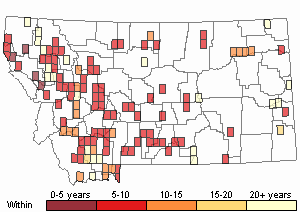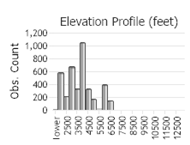View in other NatureServe Network Field Guides
NatureServe
Montana
Utah
Wyoming
Idaho
Wisconsin
British Columbia
South Carolina
Yukon
California
New York
General Description
Chara, one of the genera of green algae, grows submerged in water. Chara’s root-like rhizoids, which attach the green algae to the muddy substrate, are colorless and well-developed (DiTomaso and Kyser et al. 2013). The shoot-like central axis or stipe is ridged (Swistock and Smiles 2008) and has regularly-spaced nodes or joints. Between the nodes, the axis is solid. Whorls of slender, leaf-like branches develop from each node, some of these branches growing as long as 12 inches or more (DiTomaso and Kyser et al. 2013). These branches are ridged (Swistock and Smiles 2008).
Generally, Chara species are grayish-green and coarse. They are often covered with deposits of carbonate, which cause them to be rough to the touch and to smell like garlic or skunk when crushed (DiTomaso and Kyser et al. 2013), giving them the name of “muskgrass” (Swistock and Smiles 2008).
Diagnostic Characteristics
In Montana the Chara look like an aquatic vascular plant because it is robust, has stiff stems, and whorled branches. However, on close examination one will find that is lacks leaves, flowers, and seeds, and has a gritty texture. Once one recognizes the differences it will be easy to separate from aquatic plants.
The genus Nitella is similar to Chara. However, Nitella is very smooth to the touch because it is not encrusted with carbonates, and it lacks an unpleasant smell when crushed. Nitella tends to be a deeper green and more delicate than Chara (DiTomaso and Kyser et al. 2013; Swistock and Smiles 2008). Also, Nitella prefers acidic waters with soft, muddy bottoms rather than the hard waters that Chara usually inhabits (Swistock and Smiles 2008).
Possessing rhizoids, a central axis, and branches, Chara gametophytes are easily confused with some aquatic vascular plants, particularly species of Myriophyllum. However, the rhizoids are clear and do not have root caps or the other various structures found in roots of vascular plants. Unlike a true stem, the Chara axis does not have vascular tissue (xylem and phloem), and the filamentous branches of the whorls do not broaden into leaves (DiTomaso and Kyser et al. 2013.
Range Comments
Found throughout North America (DiTomaso and Kyser et al. 2013).
Observations in Montana Natural Heritage Program Database
Number of Observations: 3956
(Click on the following maps and charts to see full sized version)
Map Help and Descriptions
Relative Density

Recency



 (Observations spanning multiple months or years are excluded from time charts)
(Observations spanning multiple months or years are excluded from time charts)
Habitat
Ponds, lakes, reservoirs, streams, rivers, bogs, and dikes; frequently in hard, alkaline water, such as in areas of limestone and mineral springs. Some species are capable of living in brackish water (DiTomaso and Kyser et al. 2013).
Ecology
Chara is an important constituent of natural aquatic ecosystems, commonly beneficial to lakes and ponds by providing food and cover to wildlife (DiTomaso and Kyser et al. 2013). Its branches provide food for waterfowl, and foraging areas for grazing insects, who eventually provide food for fish and wildlife. Like roots, the rhizoids help prevent muddy water by stabilizing the sediment (Swistock and Smiles 2008).
Excessive Chara growth, however, may deplete water oxygen levels, jam filters, afford breeding sites for mosquitoes, impede water flow, or hamper recreational activities. Additionally, the water may smell or taste offensive once algal blooms start to decay. Excessive growth occurs with an overabundance of nitrogen and phosphorus nutrients in the water (Swistock and Smiles 2008).
Reproductive Characteristics
Sexual reproduction results in a zygote that develops into an oospore. The oospore stays dormant, awaiting favorable conditions for germination, undergoing meiosis and growing into the easily-visible gametophyte (DiTomaso and Kyser et al. 2013).
Vegetative reproduction occurs by fragmentation and other methods (DiTomaso and Kyser et al. 2013).
Management
Prevention and Cultural Control
Reduce or divert nutrient-runoff away from the pond. Such runoff originates from barnyards, septic systems, crop fields, and fertilized lawns and golf courses. This can be accomplished by reducing fertilizer treatments near ponds and lakes, properly maintaining septic systems, and retaining vegetative buffers around the ponds, lakes, and streams (Swistock and Smiles 2008). Establishing native submersed plants, can also reduce the light and space needed by Chara (DiTomaso and Kyser et al. 2013). To help prevent Chara’s spread, clean and destroy stem fragments from boats, fishing gear, and other recreational equipment (DiTomaso and Kyser et al. 2013).
Physical Control
Raking, pulling, and cutting provide only short-term control since spores and fragments left behind allow recolonization (Swistock and Smiles 2008; DiTomaso and Kyser et al. 2013).
Install bottom barriers in spring before plants have established much biomass and are still under 10 inches in height. Barrier materials include sheets of polyvinyl chloride, jute, burlap and other natural fibers, and small-mesh screens (DiTomaso and Kyser et al. 2013).
Biological Control
Algae-control products containing bacteria and/or enzymes are available. The bacteria and enzymes use the nutrients in the water, making them unavailable for algal growth (Swistock and Smiles 2008).
Stewardship Responsibility
References
- Literature Cited AboveLegend:
 View Online Publication
View Online Publication DiTomaso, J. M., and G. B. Kyser et al. 2013. Weed Control in Natural Areas in the Western United States. Weed Research and Information Center, University of California. 544 pp.
DiTomaso, J. M., and G. B. Kyser et al. 2013. Weed Control in Natural Areas in the Western United States. Weed Research and Information Center, University of California. 544 pp. Swistock, B. R., and H. Smiles. 2008. Pond Facts #22: Chara and Nitella. Penn State Extension, College of Agricultural Sciences, Pennsylvania State University, University Park, PA.
Swistock, B. R., and H. Smiles. 2008. Pond Facts #22: Chara and Nitella. Penn State Extension, College of Agricultural Sciences, Pennsylvania State University, University Park, PA.
- Additional ReferencesLegend:
 View Online Publication
View Online Publication
Do you know of a citation we're missing? Craig, V.E. 1952. A story of fish production as it applies to Montana. M.Sc. Thesis. Bozeman, MT: Montana State University. 92 p.
Craig, V.E. 1952. A story of fish production as it applies to Montana. M.Sc. Thesis. Bozeman, MT: Montana State University. 92 p. Garrett, P.A. 1983. Relationships between benthic communities, land use, chemical dynamics, and trophic state in Georgetown Lake. Ph.D. Dissertation. Bozeman, MT: Montana State University. 136 p.
Garrett, P.A. 1983. Relationships between benthic communities, land use, chemical dynamics, and trophic state in Georgetown Lake. Ph.D. Dissertation. Bozeman, MT: Montana State University. 136 p. Horpestad, A.A. 1969. Factors affecting the distribution and abundance of aquatic macrophytes in parts of the Madison, Firehole and Gibbon Rivers. M.Sc. Thesis. Bozeman, MT: Montana State University. 88 p.
Horpestad, A.A. 1969. Factors affecting the distribution and abundance of aquatic macrophytes in parts of the Madison, Firehole and Gibbon Rivers. M.Sc. Thesis. Bozeman, MT: Montana State University. 88 p. Rasmussen, S.M. 1968. Composition and structure of macrophyte vegetation of the Firehole River, Yellowstone National Park as related to physical and chemical factors. M.Sc. Thesis. Bozeman, MT: Montana State University. 44 p.
Rasmussen, S.M. 1968. Composition and structure of macrophyte vegetation of the Firehole River, Yellowstone National Park as related to physical and chemical factors. M.Sc. Thesis. Bozeman, MT: Montana State University. 44 p.
- Web Search Engines for Articles on "Chara"





